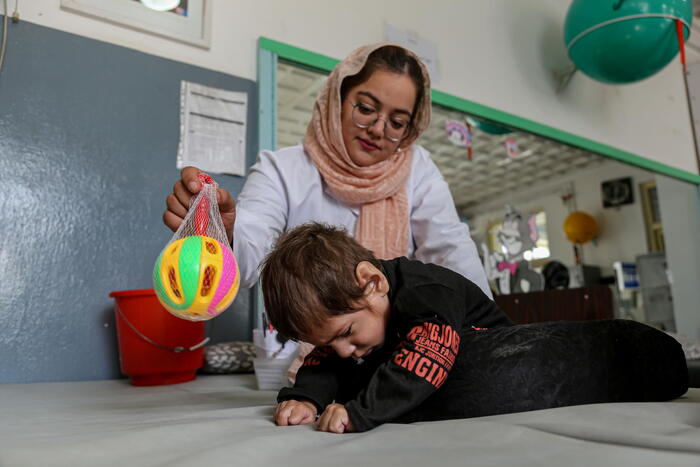Icon: enlarge
Painter and decorator (archive image)
Photo: Thierry Gouegnon / REUTERS
Defending clients, running a business or driving a bus - more men than women do this worldwide, and not just these activities: It is still the norm in employment that it is men who work and get paid for it.
Women are employed less often and work fewer hours for money.
Globally, this means: Less than half of all women of working age have a paid job.
However, women spend significantly more time doing unpaid activities such as housework, care work and field work for their own families.
The difference between the sexes in North Africa and the Middle East is particularly extreme.
The International Labor Organization (ILO) estimates the proportion of working women in these regions to be the lowest in the world.
The situation is different in sub-Saharan Africa: women are more likely to work there than in Europe.
Why does it matter whether women are employed or not?
When comparing countries, the following must be taken into account: factors such as the age distribution of society, laws and cultural norms can influence the proportion of working women.
In countries with low incomes, for example, women work on the farms or in family businesses - without being paid.
You then do not count among the employed.
Conversely, a poorly developed education system can lead to higher employment: The statistics look at women from the age of 15 - in most countries a large number of people at this age still go to school.
If young women attend school for a shorter period in a country and start working earlier, this increases the employment rate.
A lower proportion of women studying also increases the rate.
The extent to which culture, norms and political past also influence employment can be observed in Germany, for example: Fewer West German women than East German women still work full-time.
The difference is particularly large with mothers: in eastern German federal states, women with children under the age of eleven work full-time three times more often than in western Germany.
The gap between West and East has already shrunk, but even 30 years after reunification, differences can still be seen.
One factor that favors the employment of women is gender equality.
The "Sustainable Development Goals (SDG) Gender Index" records various aspects of life, such as poverty, hunger, access to water, climate impacts and equality.
The result: the higher the gender equality, the more women are in paid jobs.
And something is fundamentally happening: In most countries of the world, more women are working today than in 1980.
However, there is not a single country in the world where it has been recorded that men do more unpaid work than women.
This also applies to all European countries, as figures from the World Bank show.
The biggest difference in Europe is in Albania, where women spend 4.5 hours more than men cleaning, grooming and cooking.
In Germany, the gap is 1.5 hours, as the latest figures from 2013 show.
The smallest gender differences in this regard are found in Norway, where women were only 45 minutes ahead of men in 2011.
On average across all OECD countries, women work 30 minutes more per day - unpaid and paid work combined.
In Portugal this difference is even 90 minutes, in Germany men and women are about the same.
Women also work part-time significantly more often - but not always voluntarily: the proportion of women who involuntarily work part-time is more than twice as high as that of men across the OECD, at around five percent.
The discrepancy is particularly large in countries that already have high unemployment, such as Spain and Italy.
The fact that women work fewer hours for pay means, among other things, that they have a lower income than men.
In the OECD countries, women earn an average of 13 percent less than men.
This so-called unadjusted wage gap is influenced by the fact that women often work fewer hours - but also that jobs in which many women typically work are paid less.
It is also clear that those who work less or not at all for money run more of a risk of becoming dependent or slipping into poverty, especially in old age.
Where men would rather be hired than women
However, there are also structural reasons for the fact that fewer women are employed.
This can be seen, for example, in the global unemployment rate: women unemployment in the world is six percent higher than that of men.
So even if women want to participate in working life, they are more often without a job than men.
This in turn is often due to cultural reasons.
In India and Tunisia, for example, in 2012 the opinion was still widespread that when a job was scarce, a man should have priority over a woman if both were applying for a job.
More than 80 percent of those questioned agreed with this statement.
In Germany, at least 19 percent saw it that way.
Icon: The mirror
This contribution is part of the Global Society project
What is the Global Society project? Up arrow Down arrow
Under the heading Global Society, reporters from
Asia, Africa, Latin America and Europe
report on injustices in a globalized world, socio-political challenges and sustainable development.
The reports, analyzes, photo series, videos and podcasts appear in the international section of SPIEGEL.
The project is long-term and will be supported by the Bill & Melinda Gates Foundation (BMGF) for three years.
A detailed FAQ with questions and answers about the project can be found here.
What does the funding look like in concrete terms? Up arrow Down arrow
The Bill & Melinda Gates Foundation (BMGF) is supporting the project for three years with a total of around 2.3 million euros.
Is the journalistic content independent of the foundation? Up arrow Down arrow
Yes.
The editorial content is created without the influence of the Gates Foundation.
Do other media have similar projects? Up arrow Down arrow
Yes.
Major European media outlets such as "The Guardian" and "El País" have set up similar sections on their news pages with "Global Development" and "Planeta Futuro" with the support of the Gates Foundation.
Have there already been similar projects at SPIEGEL? Up arrow Down arrow
In recent years, SPIEGEL has already implemented two projects with the European Journalism Center (EJC) and the support of the Bill & Melinda Gates Foundation: The "Expedition The Day After Tomorrow" on global sustainability goals and the journalistic refugee project "The New Arrivals", as part of this several award-winning multimedia reports on the topics of migration and flight have been produced.
Where can I find all publications on Global Society? Up arrow Down arrow
The pieces can be found at SPIEGEL on the topic Global Society.















